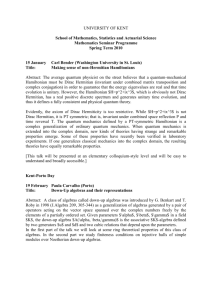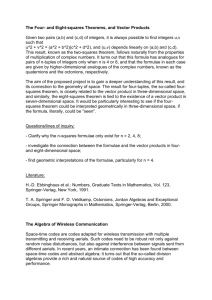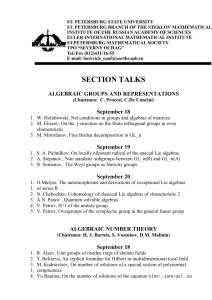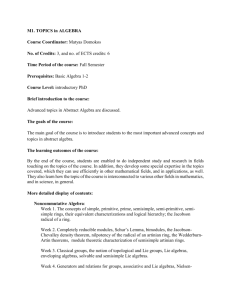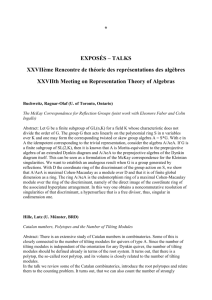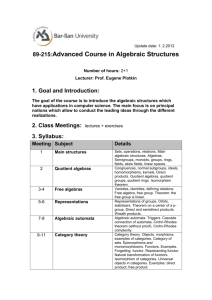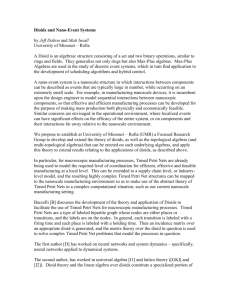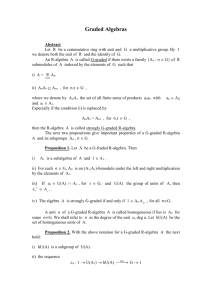Titles & Abstracts
advertisement
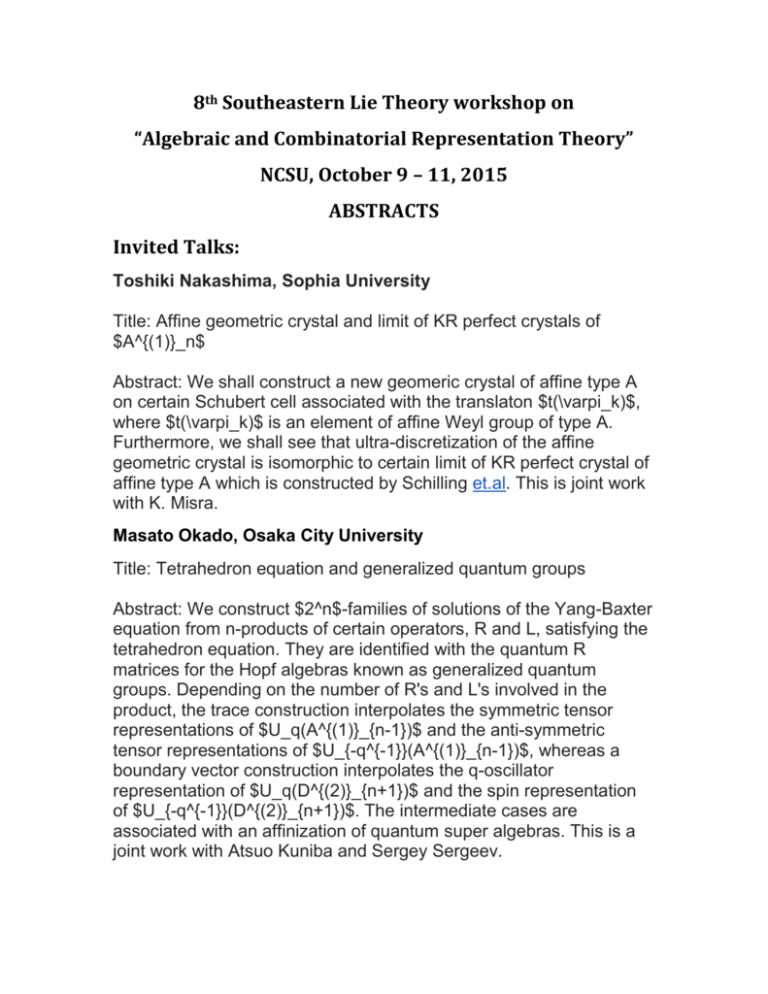
8th Southeastern Lie Theory workshop on
“Algebraic and Combinatorial Representation Theory”
NCSU, October 9 – 11, 2015
ABSTRACTS
Invited Talks:
Toshiki Nakashima, Sophia University
Title: Affine geometric crystal and limit of KR perfect crystals of
$A^{(1)}_n$
Abstract: We shall construct a new geomeric crystal of affine type A
on certain Schubert cell associated with the translaton $t(\varpi_k)$,
where $t(\varpi_k)$ is an element of affine Weyl group of type A.
Furthermore, we shall see that ultra-discretization of the affine
geometric crystal is isomorphic to certain limit of KR perfect crystal of
affine type A which is constructed by Schilling et.al. This is joint work
with K. Misra.
Masato Okado, Osaka City University
Title: Tetrahedron equation and generalized quantum groups
Abstract: We construct $2^n$-families of solutions of the Yang-Baxter
equation from n-products of certain operators, R and L, satisfying the
tetrahedron equation. They are identified with the quantum R
matrices for the Hopf algebras known as generalized quantum
groups. Depending on the number of R's and L's involved in the
product, the trace construction interpolates the symmetric tensor
representations of $U_q(A^{(1)}_{n-1})$ and the anti-symmetric
tensor representations of $U_{-q^{-1}}(A^{(1)}_{n-1})$, whereas a
boundary vector construction interpolates the q-oscillator
representation of $U_q(D^{(2)}_{n+1})$ and the spin representation
of $U_{-q^{-1}}(D^{(2)}_{n+1})$. The intermediate cases are
associated with an affinization of quantum super algebras. This is a
joint work with Atsuo Kuniba and Sergey Sergeev.
Daniel Orr, Virginia Tech
Title: Combinatorics of nonsymmetric Macdonald polynomials
Abstract: To any (possibly non-reduced) affine root system one can
associate a family of nonsymmetric Macdonald polynomials. These
polynomials exhibit many remarkable properties as well as deep
connections to geometry and representation theory.
In this talk we shall be concerned with the Ram-Yip formula, which
gives a combinatorial expression for the nonsymmetric Macdonald
polynomials based on the notion of alcove walks. I will discuss joint
work with Mark Shimozono in which we study the behavior of the
Ram-Yip formula under various specializations of the parameters in
the Macdonald polynomials. Of particular interest are the
specializations at t=0 and t=infinity, where it is possible to
characterize the surviving terms using the quantum Bruhat graph. I
will also discuss a conjectured representation-theoretic interpretation
of the nonsymmetric Macdonald polynomials at t=infinity.
Anne Schilling, UC - Davis
Lectures I&II: Crystal bases: Stembridge axioms and virtual crystals
Abstract I&II: We will introduce crystal bases for classical Lie
algebras. Our approach is through the local characterization of
simply-laced crystals given by the Stembridge axioms and the virtual
crystal construction for non-simply laced types. This is achieved by
showing that both Stembridge crystals and virtual crystals form a
tensor category. We will also explain why crystals form such a
powerful combinatorial tool for studying representation theory and
related questions.
These lectures are based on a book draft in collaboration with Dan
Bump.
Lecture III: Crystal approach to affine Schubert calculus
Abstract III: We apply crystal theory to affine Schubert calculus.
In particular, we define a crystal structure on affine factorizations
which appear in k-Schur function theory. This yields the Schur
expansion of (affine) Stanley symmetric functions and gives crystal
operators that intertwine with the Edelmann-Greene insertion (rather
than the usual RSK insertion).
This is joint work with Jennifer Morse, see
International Mathematics Research Notices 2015,
doi:10.1093/imrn/rnv194IMRN
Peter Tingley, Loyola University, Chicago
Title: Root multiplicities via quiver varieties and crystals.
Abstract: We discuss a method for estimating root multiplicities for symmetric
Kac-Moody algebras. Our work with Baumann and Kamnitzer implies that certain
root multiplicities coincide with the number of ``stable'' irreducible components of
a quiver variety. We associate to a component its string data, a word in the
nodes of the Dynkin diagram. The multiplicity is then the number of words that (i)
are valid string data, and (ii) correspond to stable components. Translating these
conditions into combinatorics is non-trivial, but in many cases they give simple
upper bounds. For instance, in rank 2, the multiplicity is bounded by the number
of rational Dyck paths satisfying a simple condition at each corner, which in turn
can be approximated by a closed form formula. We conjecture that these upper
bounds are very good, and give both computational and heuristic evidence.
Ben Webster, University of Virginia
Title: Unexpected gradings in representation theory
Abstract: A lot of interesting algebras and categories that appear in
representation theory turn out to have gradings which are not obvious
from their original definition. Examples include the group algebra of
the symmetric group over a field of positive characteristic, and
category O's for both Lie algebras and Cherednik algebras. We'll
explain how some of these gradings arise and how they enrich our
understanding of these representation theories.
Jerzy Weyman, University of Connecticut
Title: On the local cohomology of determinantal varieties
Abstract: In this talk I will discuss a joint project with Claudiu Raicu on
local cohomology of determinantal varieties. Let K be a filed of
characteristic zero. Let S=K[X_{i,j}] be a polynomail ring on the
entries of a generic m x n matrix. Denote by I_p the ideal of p x p
minors of the generic matrix X =(X_{i,j}) over S.
We give the complete description of the local cohomology groups
H^i_{I_p}(S). They turn out to be multiplicity free representations of
the group GL_m x GL_n acting on S.
Contributed Talks:
Justin Allman, Duke University
Title: Grothendieck polynomials as iterated residues
Abstract: Stable Grothendieck polynomials corresponding to
partitions represent the classes of Schubert varieties in the K-theory
of Grassmannians. It is known that their integer span forms a
commutative, cocommutative bialgebra, a result of Buch. We
describe the operations of this bialgebra by formulas similar to
generating sequences which we call iterated residue formulas. We
discuss progress on the application of the iterated residue approach
to questions of positivity.
Iana Anguelova, College of Charleston
Title: Multilocal bosonization and multilocal fermionization
Abstract: Bosonization, namely the representation of given chiral
fields (Fermi or Bose) via bosonic fields, has long been studied both
in the physics and the mathematics literature, especially in
connection to representation theory. Perhaps the best known
instance is the bosonization of the charged free fermions: one of the
two directions of an isomorphism often referred to as "the" bosonfermion correspondence. The opposite process, fermionization,
refers to the representation of given fields in terms of fermionic fields,
as in the case of the representation of the Heisenberg bosonic
current as a normal ordered product of the two charged fermions. In
this talk we present a new approach, using multi-locality, instead of
the usual 1-point locality, to construct new instances of bosonization
and fermionization. One is the multilocal bosonization of the
$\beta\gamma$ boson ghost system, and generally of the symplectic
bosons (and consequently certain classes of lattice vertex algebras).
The other is the multilocal fermionization of the charged free fermions,
and generally certain other classes of lattice vertex algebras.
Eric Bucher, Louisiana State University
Title: Sequences of Quiver Mutations on Surfaces
Abstract: Given a marked surface (S,M) we can add arcs to the
surface to create a triangulation, T, of that surface. For each
triangulation, T, we can associate a cluster algebra. We will introduce
how to construct a cluster algebra and quiver from this surface and
hen in the sense of work by Keller we will produce a maximal green
sequence for this quiver. Since all finite mutation type cluster
algebras can be associated to a surface, with some rare exceptions,
this work along with previous work by others seeks to establish a
base case in answering the question of whether a given finite
mutation type cluster algebra exhibits a maximal green sequence.
Jason Elsinger, Spring Hill College
Title: Orbifolds of lattice vertex algebras under an isometry of order
two
Abstract: Every isometry of a positive-definite even lattice $Q$ can
be lifted to an automorphism of the lattice vertex algebra $V_Q$. An
important problem in vertex algebra theory is to classify the
representations of the $\sigma$-invariant subalgebra
$V_Q^\sigma$ of $V_Q$, known as an orbifold. In the case when
$\sigma$ is an isometry of $Q$ of order two, we classify the
irreducible modules of the orbifold vertex algebra $V_Q^\sigma$ and
identify them as submodules of twisted or untwisted $V_Q$ modules.
Examples where $Q$ is a root lattice and $\sigma$ is a Dynkin
diagram automorphism as well as $Q$ being a direct sum of two
copies of a lattice $L$ and $\sigms$ is the cyclic permutation are
presented in detail.
William Hardesty, University of Georgia
Title: On Support Varieties and the Humphreys Conjecture in type
$A$
Abstract: Let $G$ be a reductive algebraic group scheme defined
over $\mathbb{F}_p$ and let $G_1$ denote the Frobenius kernel of
$G$. To each finite-dimensional $G$ module $M$, one can define the
support variety $V_{G_1}(M)$, which can be regarded as a $G$stable closed subvariety of the nilpotent cone. A $G$-module is
called a tilting module if it has both good and Weyl filtrations. In 1997,
it was conjectured by J.E. Humphreys that when $p\geq h$, the
support varieties of the indecomposable tilting modules align with the
nilpotent orbits given by the Lusztig bijection. We shall verify this
conjecture when $G=SL_n$ and $p > n+1$.
Thorsten Heidersdorf, Ohio State University
Title: Ideals in Deligne's category $Rep(O_{\delta})$ and
representations of the Orthosymplectic Supergroup
Abstract: We describe indecomposable objects in Deligne's category
$Rep(O_{\delta})$ and explain how to decompose their tensor
products. We then classify thick ideals in $Rep(O_{\delta})$. As an
application we classify the indecomposable summands of tensor
powers of the standard representation of the orthosymplectic
supergroup up to isomorphism.
Patricia Hersh, NC State University
Title: From the weak Bruhat order to the crystal poset
Abstract: We investigate the way in which well-known properties of
the weak Bruhat order on a Weyl group can be lifted (or not) to a
corresponding crystal graph, viewed as a partially ordered set; the
latter projects to the weak order via the so-called key map. First, a
crystal theoretic analogue of the statement that any two reduced
expressions for the same Coxeter group element are related by
Coxeter moves is proven for all lower intervals in a crystal graph. On
the other hand, it is shown that no finite set of moves exist, even in
type A, for arbitrary crystal graph intervals. Second, it is shown for
lower intervals (0,v) that the M ̈obius function is always 0 or ±1, and a
precise description is given. For general intervals (u,v), examples
exist with arbitrarily large M ̈obius function, again even in type A.
Moreover, the order complex for the intervals (0,v) is proven always
to be homotopy equivalent to a ball or to a sphere of some dimension,
despite often not being shellable. This is joint work with Cristian
Lenart.
Chun-Ju Lai, University of Virginia
Title: Schur duality, canonical bases, and quantum symmetric pairs
of affine type
Abstract: Recently, generalizing the work of Beilinson, Lusztig, and
MacPherson of finite type A, Bao, Kujawa, Li, and Wang constructed
the quantum algebras arising from partial flag varieties of finite type
B/C, altogether with their canonical bases. They also provided a
geometric realization of a Schur-type duality between these algebras
and the Hecke algebras of type B acting on a tensor space. These
quantum algebras are coideal subalgebras of quantum gl(n), which
also form quantum symmetric pairs, with quantum gl(n). The
canonical bases arising from quantum symmetric pairs was used by
Bao-Wang to formulate Kazhdan-Lusztig theory for BGG category O.
The above can be reformulated within the framework of Hecke
algebras without geometry.
In this talk I will explain the affinization of above in two (Hecke
algebra theoretic and geometric) approaches. This is a joint work
with Zhaobing Fan, Yiqiang Li, Li Luo, and Weiqiang Wang.
David Lax, UNC-Chapel Hill
Title: Explicit Standard Monomial Basis for Coordinatization of Type
A Schubert Varieties
Abstract: A flag manifold for GL(n) can be concretely projectively
coordinatized using products of minors as coordinates. These
products are nicely indexed by tableaux on a Young diagram.
Lakshmibai, Musili, and Seshadri gave a standard monomial basis for
the projective coordinates when restricted to a Schubert subvariety.
Reiner and Shimozono made this theory more explicit by giving a
straightening algorithm for the products of the minors in terms of the
right key of a semistandard Young tableau. Since then, Willis
introduced scanning tableaux as a more direct way to obtain right
keys. We use scanning tableaux to give more-direct proofs of the
spanning and the linear independence of the standard monomials.
This basis is a weight basis for the dual of a Demazure module for a
Borel subgroup of GL(n). As a result, we independently obtain an
expression for these Demazure characters as sums of weights over
the tableaux used to index the standard monomial bases.
Jesse Levitt, Louisiana State University
Title: Connected Hopf algebras as deformations of universal
enveloping algebras
Abstract: The classification problem for connected Hopf algebras of
finite GK dimension has attracted much attention in recent years.
Recently, a classification of all such Hopf algebras of GK dimension 4
was devised in part using Coassociative Lie Algebras to construct
deformed universal enveloping algebras. Motivated by this, we invoke
a Drinfeld construction to produce non-cocommutative Hopf algebras
on completions of universal enveloping algebras. In this joint work
with Milen Yakimov, we describe necessary and sufficient conditions
for deformed universal enveloping algebras to be connected Hopf
Algebras and show how previous classifications follow from the
Drinfeld construction.
Robert Muth, University of Oregon
Title: Skew Specht modules and cuspidal modules in affine type A
Abstract: A key role in the representation theory of the symmetric
group, and cyclotomic Hecke algebras more generally, is played by
certain modules called Specht modules, which are labeled by Young
diagrams. In the affine setting of the KLR algebra of type A, one may
construct a more general class of Specht modules associated to
skew diagrams. Cuspidal modules, which form the building blocks of
the representation theory of KLR algebras, can be viewed as specific
examples of skew Specht modules associated to hook shapes.
Chad Mangum, Niagara University
Title: Free Field Representations of Twisted Toroidal Lie Algebras
Abstract: Lie algebra representation theory has been significant in
various areas of mathematics and physics for several decades. In this
talk, we will discuss one instance of this theory, namely certain
representations of twisted (2-)toroidal (Lie) algebras, which we view
as universal central extensions of twisted multi-loop algebras. The
loop algebra realization generalizes the familiar realization of affine
Kac-Moody algebras. To facilitate our study of the representation
theory, we will first discuss an alternative presentation of twisted
toroidal algebras given via generators and relations. Subsequently,
we will discuss a free field representation (which is similar to that of a
landmark work by Feingold and Frenkel in the case of affine
algebras). This is joint work with Dr. Kailash Misra and Dr. Naihuan
Jing.
Jacob Matherne, Louisiana State University
Title: Combinatorics of exceptional sequences in type A
Abstract: Exceptional sequences are certain ordered sequences of
quiver representations. We introduce a class of objects called strand
diagrams and use this model to classify exceptional sequences of
representations of a quiver whose underlying graph is a type A_n
Dynkin diagram. We also use variations of this model to classify cmatrices of such quivers, to interpret exceptional sequences as linear
extensions of posets, and to give a simple bijection between
exceptional sequences and certain chains in the lattice of
noncrossing partitions. This is a joint work with Alexander Garver,
Kiyoshi Igusa, and Jonah Ostroff.
Radmila Sazdanovic, NC State University
Title: Categorification of Chebyshev polynomials
Abstract: We introduce a diagrammatic categorification of the onevariable polynomial ring Z[x] which leads to categorification of some
basic special functions such as Chebyshev polynomials.
Lisa Schneider, Susquehanna University
Title: Demazure Flags of Demazure Modules
Abstract: In this talk, we study a family of Demazure modules in the
affine setting that are also modules of the maximal parabolic
subalgebra. Then, we define the Demazure flag of a module for the
current algebra and q-multiplicities associated to a Demazure flag. In
particular, we are interested in Demazure flags of level m-Demazure
modules. For the lie algebra of type A_1, we consider non-split short
exact sequences to define two different recursions of q-multiplicities.
In specific cases, we have closed forms for the q multiplicities. Then,
we consider generating functions with q-multiplicities as coefficients
and observe (when possible) the connections to partial and mocktheta functions as well as Chebyshev polynomials.
Paul Sobaje, University of Georgia
Title: Lifting representations for algebraic groups
Abstract: We will look at the problem of determining when a module
for a Frobenius kernel of an algebraic group $G$ lifts to $G$.
Xin Tang, Fayetteville State University
Title: Automorphisms of Multiparameter Quantized Weyl Algebras
Abstract: In this talk, we give complete description of the
automorphism group of a class of multiparameter quantized Weyl
algebras and their central extensions. A few applications will be
discussed as well.
Ryan Vinroot, College of William and Mary
Title: Kostka multiplicity one for multipartitions
Abstract: If $[\lambda(j)]$ is a multipartition of the positive integer
$n$ (a sequence of partitions with total size $n$), and $\mu$ is a
partition of $n$, we study the number $K_{[\lambda(j)]\mu}$ of
sequences of semistandard Young tableaux of shape
$[\lambda(j)]$ and total weight $\mu$. We show that the numbers
$K_{[\lambda(j)] \mu}$ occur naturally as the multiplicities in certain
permutation representations of wreath products. The main result is a
set of conditions on $[\lambda(j)]$ and $\mu$ which are equivalent to
$K_{[\lambda(j)] \mu} = 1$, generalizing a theorem of
Berenshte\u{\i}n and Zelevinski\u{\i}. We also show that the
questions of whether $K_{[\lambda(j)] \mu} > 0$ or $K_{[\lambda(j)]
\mu} = 1$ can be answered in polynomial time, expanding on a result
of Narayanan. Finally, we give an application to multiplicities in the
degenerate Gel'fand-Graev representations of the finite general linear
group, and we show that the problem of determining whether a given
irreducible representation of the finite general linear group appears
with nonzero multiplicity in a given degenerate Gel'fand-Graev
representation, with their partition parameters as input, is $NP$complete.
Evan Wilson, Ursinus College
Title: Completely pointed modules of U_q(sl_n)
Abstract: Completely pointed modules are weight modules whose
weight spaces are one dimensional. In this talk, we give a
classification of completely pointed modules of the quantum group for
U_q(sl_n) which was recently obtained by the author with Vyacheslav
Futorny and Jonas Hartwig.
